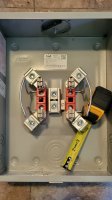Joshua5438
Member
I am installing a meter can and main panel on a metal building. This will be a 200amp service so I will be using 3/0 cu wire. I had originally planned to mount my main panel directly behind my meter can on the inside of my exterior wall. Feed the wire through a 2" nipple between the two panels. In searching I have realized that this is against code based on 312.6 (unless I am reading it wrong). If I am correct, how else can I feed my main panel? I am guessing I will have to use a top or bottom exit from the meter can instead of a back exit? How would I feed the cable into the building and could I use a back feed in the main panel or would I need to come in from the top or bottom also? I am having a hard time picturing my options.


